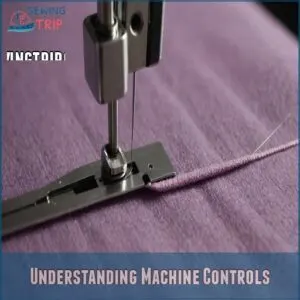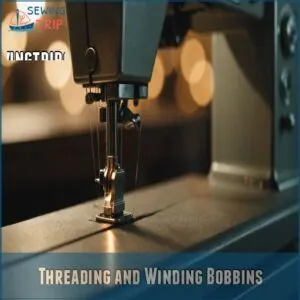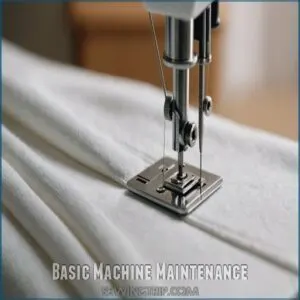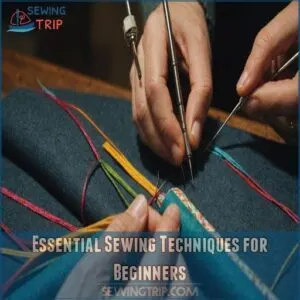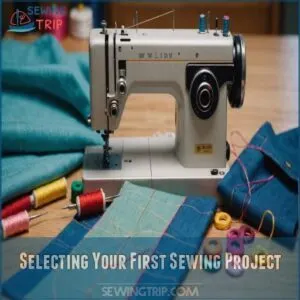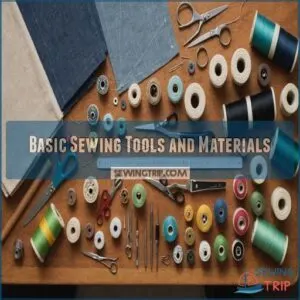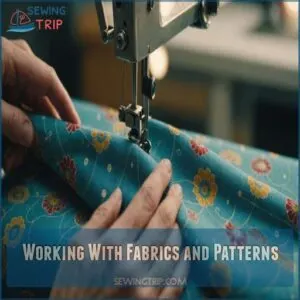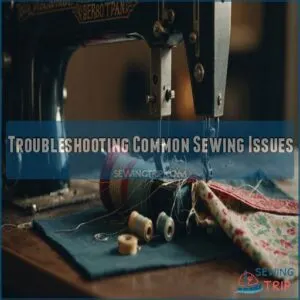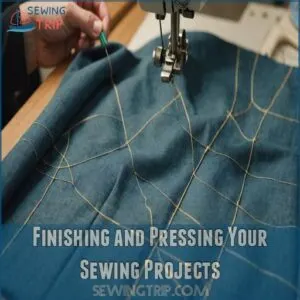This site is supported by our readers. We may earn a commission, at no cost to you, if you purchase through links.
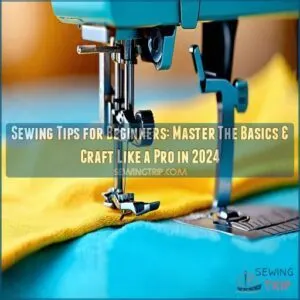 Starting your sewing journey doesn’t have to feel like threading a needle in the dark.
Starting your sewing journey doesn’t have to feel like threading a needle in the dark.
These essential sewing tips for beginners will set you up for success.
Start with simple projects like pillowcases or tote bags, using cotton fabric that’s forgiving and easy to handle.
You’ll want to master basic stitches, which include the running, back, and slip stitch that can be learned by hand before using a sewing machine guide – think of it as learning to walk before you run.
Keep your workspace organized, maintain proper posture, and remember: even seasoned sewists started exactly where you are.
With the right tools and techniques at your fingertips, you’ll be amazed at how quickly those wobbly stitches transform into professional-looking creations.
Table Of Contents
- Key Takeaways
- Getting Started With Sewing
- Learning The Basics of Sewing Machines
- Essential Sewing Techniques for Beginners
- Selecting Your First Sewing Project
- Basic Sewing Tools and Materials
- Working With Fabrics and Patterns
- Troubleshooting Common Sewing Issues
- Finishing and Pressing Your Sewing Projects
- Time-Saving Tips and Tricks for Beginners
- Frequently Asked Questions (FAQs)
- Conclusion
Key Takeaways
- Start with simple projects like pillowcases or tote bags using easy-to-handle cotton fabric to build your skills and confidence.
- Master basic stitches such as straight, zigzag, and backstitch before moving on to more complex patterns.
- Organize your sewing space with good lighting, a comfy chair, and accessible storage to enhance your efficiency and comfort.
- Regularly maintain your sewing machine by cleaning, oiling, and checking thread tension to ensure smooth operation and quality results.
Getting Started With Sewing

You’re about to start an exciting journey into sewing, where creativity meets craftsmanship.
With a few basic tools, some patience, and a dash of enthusiasm, you’ll be stitching up a storm in no time – just don’t prick your finger on the first try!
Essential Sewing Terms
Ever felt like sewing lingo’s a foreign language?
Don’t sweat it!
Mastering sewing terminology is your first step to becoming a fabric ninja.
From basic stitches to fancy seams, you’ll soon be tossing around terms like "basting" and "bias tape" like a pro.
Grab a sewing dictionary or hop online – there’s a treasure trove of sewing tutorials waiting.
As you jump into projects, you’ll pick up fabric names and tool talk naturally.
Before you know it, you’ll be stitching up a storm!
Setting Up a Sewing Space
Now that you’ve got the lingo down, let’s talk about setting up your sewing sanctuary.
Consider a well-lit spot, ideally near a window, for natural light and inspiration from colors that fuel your creativity like choosing the perfect sewing space.
Find a spot with good lighting – natural light is your BFF here.
Invest in a comfy chair and an adjustable table to save your back.
Keep your tools within arm’s reach with smart storage solutions.
Remember, an organized space equals a happy sewist.
It’s like giving your creativity a cozy home!
Choosing The Right Sewing Machine
Choosing the right sewing machine can feel like finding a needle in a haystack, but don’t worry! You’ll be stitching up a storm in no time.
When shopping for your beginner sewing machine, keep these key factors in mind:
- Features: Look for adjustable stitch length and width, built-in buttonhole, and free arm for cuffs and sleeves.
- Budget: Set a realistic price range, but remember, quality pays off in the long run.
- User reviews: Real-world experiences can be gold when comparing brands and models.
Learning The Basics of Sewing Machines
You’re about to discover the secrets of your sewing machine, and trust me, it’s not as scary as it looks!
To get started, it’s essential to understand the sewing machine parts Master Your Machine Basics and how they work together to create a seamless sewing experience. Get ready to tame that metal beast and turn it into your crafting sidekick as we explore the basics of sewing machines together.
Understanding Machine Controls
You’ve got your sewing machine set up, now let’s tame that beast!
Understanding machine controls is like learning to drive – it might seem challenging, but you’ll be cruising in no time.
To get started with sewing, it’s essential to master basic sewing supplies and techniques, such as understanding different fabric types and prep methods. Start with the basics: sewing machine speed and stitch length.
Play around with different settings on scrap fabric.
Don’t forget to adjust the tension and foot pressure for different fabrics.
Remember, practice makes perfect, so don’t be afraid to experiment.
Soon, you’ll be switching between buttonhole settings like a pro!
Threading and Winding Bobbins
Threading your machine and winding bobbins might seem like a puzzle at first, but it’s the key to smooth sewing.
Let’s unravel this mystery together!
Here’s a quick guide to get you started:
- Follow your machine’s threading diagram carefully
- Use the bobbin winder to load thread evenly
- Insert the bobbin into its case, ensuring proper tension
Remember, practice makes perfect. Don’t get discouraged if it takes a few tries – soon you’ll be threading and winding like a pro!
Basic Machine Maintenance
Now that you’ve mastered threading, let’s keep your trusty machine humming.
Regular cleaning is key – brush out lint and dust after each project.
A drop of oil in the right spots keeps things running smooth.
Check your needle often; a dull one’s a recipe for trouble.
Keep an eye on tension, and store your machine covered.
With a little TLC, your sewing companion will stick with you through thick and thin, ready for your next creative adventure.
Essential Sewing Techniques for Beginners
Ready to level up your sewing game? You’ll be stitching like a pro in no time as we explore essential techniques that’ll turn your fabric dreams into reality.
Choosing The Right Needle and Thread
With the right needle and thread, you’ll breeze through projects like a pro.
Match your needle type to your fabric – lightweight for delicates, heavy-duty for denim.
Thread weight matters too; finer threads for silks, sturdier ones for canvas.
Consider the importance of choosing the right needle size to prevent skipped stitches, puckering, and thread breakage.
Don’t forget color!
Pick a shade that blends or pops, depending on your style.
Remember, the right combo is like a perfect dance partner – it’ll make your sewing smooth and effortless.
So, let’s get those stitches in sync!
Mastering Basic Stitches
You’ve got your needle and thread ready, so let’s tackle the bread and butter of sewing: mastering basic stitches.
It’s like learning to walk before you run, but trust me, you’ll be sprinting through projects in no time!
Here are three game-changing stitches to get under your belt:
- Straight stitch: Your go-to for seams and topstitching
- Zigzag stitch: Perfect for finishing edges and stretchy fabrics
- Backstitch: The unsung hero for reinforcing seams and hand sewing
Practice these, and you’ll be stitching like a pro!
Gathering and Seam Finishing
Ready to take your sewing skills up a notch? Let’s explore gathering and seam finishing! These techniques give your projects that professional edge.
For gathering, try the basting method or use your machine’s longest stitch.
Seam finishes are like the secret sauce of sewing. Experiment with serging edges for a clean look, or try a Hong Kong finish for a touch of luxury. Flat felled seams are perfect for durability.
Remember, practice makes perfect, so don’t be afraid to test these methods on scrap fabric first!
Selecting Your First Sewing Project
Ready to tackle your first sewing project?
You’re in for a treat!
Pick a simple pattern, grab some beginner-friendly fabric, and get ready to stitch your way to success—it’s easier than you think, and way more fun than wrestling with a tangled ball of yarn.
Choosing a Simple Pattern
Now that you’ve got the basics down, let’s pick your first sewing pattern! It’s like choosing your first dance partner – you want something that won’t step on your toes. Look for beginner-friendly patterns with clear instructions and minimal pieces.
Here’s what to keep in mind:
- Simplicity is key – think pillowcases or tote bags
- Check pattern reviews for sizing accuracy and difficulty level
- Start small to build confidence and avoid frustration
Remember, even a simple project can spark joy and creativity. You’ve got this!
Selecting The Right Fabric
Choosing the right fabric can make or break your first sewing project.
For beginners, opt for medium-weight woven fabrics like cotton or linen. They’re forgiving and easy to handle.
Consider fabric weight, texture, and drape to match your pattern.
Don’t forget about fabric care – prewash to prevent surprises later.
Start with affordable options as you learn.
Remember, different fabric types behave differently, so explore and experiment.
Your perfect fabric match is out there, waiting to bring your creation to life!
Following Step-by-Step Instructions
With your fabric selected, it’s time to tackle those step-by-step instructions.
Don’t let them intimidate you – they’re your roadmap to sewing success!
Here’s how to make sense of those patterns:
- Read through the entire guide before you start
- Highlight or mark key steps to avoid missing anything
- Take it slow – Rome wasn’t sewn in a day!
- Use visual aids like YouTube videos for tricky parts
Remember, following instructions is like learning a new dance.
You might stumble at first, but soon you’ll be grooving through projects with ease!
Basic Sewing Tools and Materials
You’ll need a trusty toolkit to start your sewing journey, just like a chef needs their knives.
From sharp scissors to precise measuring tools, these handy helpers will make your projects a breeze and help you stitch like a pro in no time.
Scissors and Cutting Tools
Got your pattern? Great! Let’s talk about the tools that’ll turn that fabric into your dream project.
Sharp scissors are your new best friend – they’ll slice through fabric like butter. You can find the perfect pair of fabric scissors online, suited to your sewing needs.
Fabric shears, pinking shears, and thread snips each have their sweet spot.
Don’t forget the rotary cutter for those long, straight cuts. It’s like a pizza wheel for fabric! Just watch those fingers – these tools mean business. Ready to make the cut?
Pins, Needles, and Notions
Let’s explore the realm of pins, needles, and notions – your trusty sidekicks in the sewing adventure!
These tiny tools pack a punch, helping you create magic with fabric.
Here’s what you’ll need in your sewing arsenal:
- Glass-head pins for easy gripping
- Sharp needles in various sizes
- Quality thread that matches your fabric
- Seam rippers for those "oops" moments
Don’t skimp on these essentials – they’re the backbone of your sewing success.
Organize them well, and you’ll be stitching like a pro in no time!
Measuring and Marking Tools
Now that you’ve got your pins and needles sorted, it’s time to talk about measuring and marking tools.
These gadgets are your secret weapons for precision sewing.
You’ll feel like a pro with a measuring tape in hand, ready to conquer any project.
Here’s a quick rundown of must-have tools:
| Tool | Use | Pro Tip |
|---|---|---|
| Measuring tape | Accurate measurements | Keep it flat for best results |
| Fabric shears | Clean, precise cuts | Don’t use on paper! |
| Rotary cutter | Quick, straight cuts | Change blades regularly |
Working With Fabrics and Patterns
You’re about to enter the fabric jungle, where patterns are your treasure map!
Get ready to tame those textiles and decode pattern mysteries as we explore the exciting world of working with fabrics and patterns.
Fabric Types and Preparation
Diving into fabric types can feel like exploring a new world, but don’t worry – we’ve got your back!
Start by getting to know different fabric weights.
Light fabrics like chiffon dance in the breeze, while heavy ones like denim stand their ground.
When choosing fabric, consider your project’s needs, and for more guidance, check out various sewing patterns online sewing patterns designs.
A flowy dress calls for something light, while sturdy jeans demand a tougher material.
Fabric care is important too – some need tender loving care, while others can take a beating.
Remember, each fabric has its own personality.
Cotton’s your easygoing friend, silk’s the fancy one, and polyester’s ready for anything.
As you explore, you’ll develop a sixth sense for fabric types and their quirks.
Prewashing and Cutting Fabric
You’ve got your fabric, but hold your horses.
Before you start snipping, there’s an important step: prewashing, which helps prevent shrinkage and color bleeding, especially for natural fibers like cotton and linen, so make sure to check How to prewash different fabric types.
Think of it as giving your fabric a spa day to prevent any future shrinkage surprises.
Once it’s fresh and clean, it’s time to play pattern Tetris.
Lay out your pattern pieces on the fabric, following those mysterious grain lines.
They’re like fabric compasses, guiding you to sewing success.
Now, grab your trusty rotary cutter or scissors – whichever floats your boat.
Cut with confidence, but don’t rush it.
Remember, measure twice, cut once!
And don’t forget to transfer those funky markings.
They’ll be your roadmap when you’re knee-deep in stitches later on.
Troubleshooting Common Sewing Issues
You’ll face some hiccups as you learn to sew, but don’t worry – it’s all part of the journey!
Let’s tackle common issues like wonky stitches and tangled threads, so you can keep your projects on track and your sewing machine humming happily.
Thread Tension and Puckering
Ever feel like your fabric’s throwing a fit? Let’s tackle thread tension and puckering head-on! These pesky issues can turn your dream project into a nightmare.
To keep things smooth, start by adjusting your machine’s tension dial. If your stitches look like a rollercoaster, you’re too tight. Too loose? You’ll see loops. Find that sweet spot where top and bottom threads meet in harmony.
Remember, different fabrics need different tensions, so don’t be afraid to play around!
Skipping Stitches and Machine Errors
When mastering a straight stitch is key to preventing this issue, as it helps with thread tension and stitch length, check out how to easily sew basics of hand sewing. When your sewing machine starts skipping stitches, it’s like your trusty sidekick has a hiccup.
Don’t panic!
First, check if your needle’s dull or bent – it’s often the culprit.
Rethread your machine, ensuring proper tension.
If problems persist, clean out lint and oil moving parts.
Still stumped?
Your timing might be off.
Remember, regular maintenance is key to keeping your machine humming.
With a bit of troubleshooting, you’ll be back to crafting in no time!
Seam and Hemming Issues
Tackling seam and hemming issues? Don’t sweat it!
First, check your seam allowance.
If it’s off, your project might look wonky.
To avoid common satin sewing problems, make sure to check thread tension.
For uneven hems, grab a seam ripper and start fresh.
Try different hemming techniques like blind hems or rolled edges for a polished look.
Invest in handy hemming tools like a hem gauge or fusible tape for smoother sailing.
Remember, practice makes perfect, so keep at it!
Soon, you’ll be whipping up pro-level seams and hems without breaking a sweat.
Finishing and Pressing Your Sewing Projects
You’re almost at the finish line with your sewing project, but don’t put away that iron just yet!
Proper pressing and finishing touches can turn your handmade creation from "meh" to "wow," giving it that professional polish that’ll make you proud to show it off.
Pressing Tools and Techniques
You’ve mastered troubleshooting, now let’s press on!
A good iron is your new best friend.
Choose one with adjustable heat settings to handle different fabrics.
Invest in a pressing cloth to protect delicate materials.
Steam can be a game-changer for stubborn wrinkles.
Don’t forget about seam rolls and tailor’s hams – they’re lifesavers for curved areas.
Remember, pressing isn’t just ironing; it’s about shaping your project.
Take your time and press between steps for a polished finish.
Blocking and Shaping Garments
Transform your homemade garments from flat to fabulous with blocking and shaping techniques.
Steam blocking works wonders for wool and knits, while spray blocking suits delicate fabrics.
Pin your garment to the ironing board, apply steam or spray, and let it dry naturally.
This process helps you:
- Achieve that "tailor-made" look you’ve been dreaming of
- Boost your confidence in your sewing skills
- Create garments that fit like a glove
- Feel proud every time you wear your handmade creations
Remember, patience is key when shaping seams and perfecting garment fit.
Final Touches and Details
Now that you’re in the home stretch, let’s add those final touches that’ll make your project shine.
From hemming to buttons, it’s time to put a bow on your creation.
Here’s a quick guide to help you finish like a pro:
| Task | Technique | Pro Tip |
|---|---|---|
| Hemming | Double-fold | Press as you go |
| Buttons | Hand-sewn | Use thread shanks |
| Zippers | Invisible | Baste first |
| Pressing | Steam iron | Test on scrap |
Remember, these finishing touches are your project’s handshake.
They’ll make all the difference, so take your time and enjoy the process!
Time-Saving Tips and Tricks for Beginners
You’re about to discover the secrets of sewing efficiency, and trust me, it’s not rocket science!
With these time-saving tips and tricks, you’ll soon be stitching up a storm without breaking a sweat or losing your cool.
Organization and Workspace Management
A tidy workspace is your secret weapon for sewing success.
Invest in smart storage solutions like pegboards and drawer organizers to keep your tools at your fingertips.
Design your sewing space with ergonomics in mind – a comfortable chair and well-lit area can be game-changers.
Create a "sewing essentials" kit for quick access to frequently used items.
Remember, an organized space isn’t just pretty – it’s a time-saving powerhouse that’ll have you crafting like a pro in no time!
Sewing Assembly Line and Efficiency
Ready to supercharge your sewing? Let’s talk assembly line efficiency!
Start by batch cutting your fabric pieces – it’s a game-changer.
Plan your workflow like a pro, lining up similar tasks.
Embrace the power of chain piecing; it’s like a sewing express lane.
Keep your workspace tidy and tools within reach.
Remember, a well-oiled sewing machine is your best friend.
With these time-saving tricks up your sleeve, you’ll be crafting like a seasoned pro in no time!
Avoiding Common Mistakes and Frustrations
Behind every seamstress’s success lies a trail of tangled threads and wonky seams – but you’ve got this.
Check your thread tension before starting; it’ll save headaches later.
Make sure you’re using the right sewing thread supplies for your project.
When stitches skip or seams pucker, take a breather and double-check your machine settings.
Keep your workspace tidy, and don’t rush through pattern fitting.
Remember, even pros started somewhere, and those "happy accidents" often lead to creative solutions and newfound confidence.
Frequently Asked Questions (FAQs)
What do you need to know about sewing?
You’ll need a reliable sewing machine, basic tools like scissors and pins, and understanding of fabric types.
Start with simple projects and master essential stitches like the backstitch, which creates a continuous line of interlocking stitches, by learning how to sew a seam to build confidence while mastering essential stitches and pattern reading.
How do I learn to sew for the first time?
Despite what perfectionists say, start with cotton fabric and simple projects.
Grab a basic machine, thread it up, and practice straight stitches.
Before you know it, you’ll be stitching like a pro!
Is it time to practice sewing for beginners?
Start practicing sewing now!
Grab some scrap fabric, thread your machine, and jump right into basic stitches.
Don’t wait for the perfect moment – every stitch you make today builds confidence for tomorrow’s projects.
Are there any sewing Tips & Tricks?
Practice on scrap fabric first to build confidence.
Keep your machine well-oiled, choose quality thread, and maintain proper tension.
When you’re stuck, YouTube tutorials are your best friend for quick fixes.
What Fabrics and Materials Are Best for Beginners?
Like a gentle breeze guides a leaf, cotton fabric will guide your sewing journey.
You’ll find it’s forgiving and easy to handle.
Medium-weight woven fabrics and quilting cotton are perfect starting points.
How Do I Thread a Sewing Needle?
Cut your thread at a 45-degree angle for a sharp point.
Thread through the needle’s eye is easier in good lighting.
Hold it steady against a white background.
What Are Some Common Mistakes Beginners Make?
When first starting out, many beginners neglect to follow the thread guide, tension discs, take-up lever, and needle eye to thread their machine Threading Your Machine. Around 70% of beginners forget to check sewing machine settings before starting.
You’ll often skip prewashing fabric, resulting in shrinkage surprises.
Rushing without reading patterns fully is another pitfall.
Slow down, breathe, and enjoy the process!
Where Can I Find Sewing Patterns for Beginners?
Check out online shops like Etsy or Joann Fabrics!
Many offer beginner-friendly patterns.
Local craft stores also often stock them.
You’ll find tons of simple projects to boost your confidence.
Happy sewing!
How Do I Finish Seams Properly?
Did you know that finishing seams can boost garment longevity by 30%?
To do it right, try techniques like zigzag or overlocking.
They add strength and a clean look, making your project ready for its close-up!
How do I prevent fabric from pilling after washing?
Stop fabric from pilling by washing it inside out on a gentle cycle.
Skip hot water and reduce friction with a fabric softener.
Also, avoid overloading your washer; it’s like trying to stuff an elephant into a Mini!
Whats the best lighting setup for night sewing?
Illuminate your sewing area with a bright task lamp and adjustable LED lights.
Balance lighting so it feels cozy, not blinding.
Adding a daylight bulb helps you see colors true and crisp—it’s like sewing in sunshine!
Can I use regular scissors instead of fabric scissors?
Imagine slicing through fabric like butter or hacking it like a wild hair day.
You can use regular scissors, but they’ll dull quickly and might fray fabric.
Investing in fabric scissors saves time and guarantees smoother cuts.
How often should I replace my sewing machine needle?
Change your sewing machine needle every 8-10 hours of sewing or after each major project.
This keeps your stitches sharp and your machine happy.
Trust me, it’s like giving your machine a little spa day!
Which fabrics are most resistant to pet hair?
You’re in luck! Fabrics like microfiber and tightly woven materials, such as denim or leather, resist pet hair really well.
The smoother the fabric, the harder it’s for hair to cling.
Give it a try!
Conclusion
So, you’ve tackled these sewing tips for beginners? Fantastic!
Remember, even a wonky stitch is a step forward.
Don’t be afraid to experiment; that’s how you truly learn.
Practice makes perfect, and soon you’ll be whipping up amazing creations.
These sewing tips for beginners are your springboard to a world of crafty fun.
Celebrate your progress, no matter how small.
Happy sewing!

